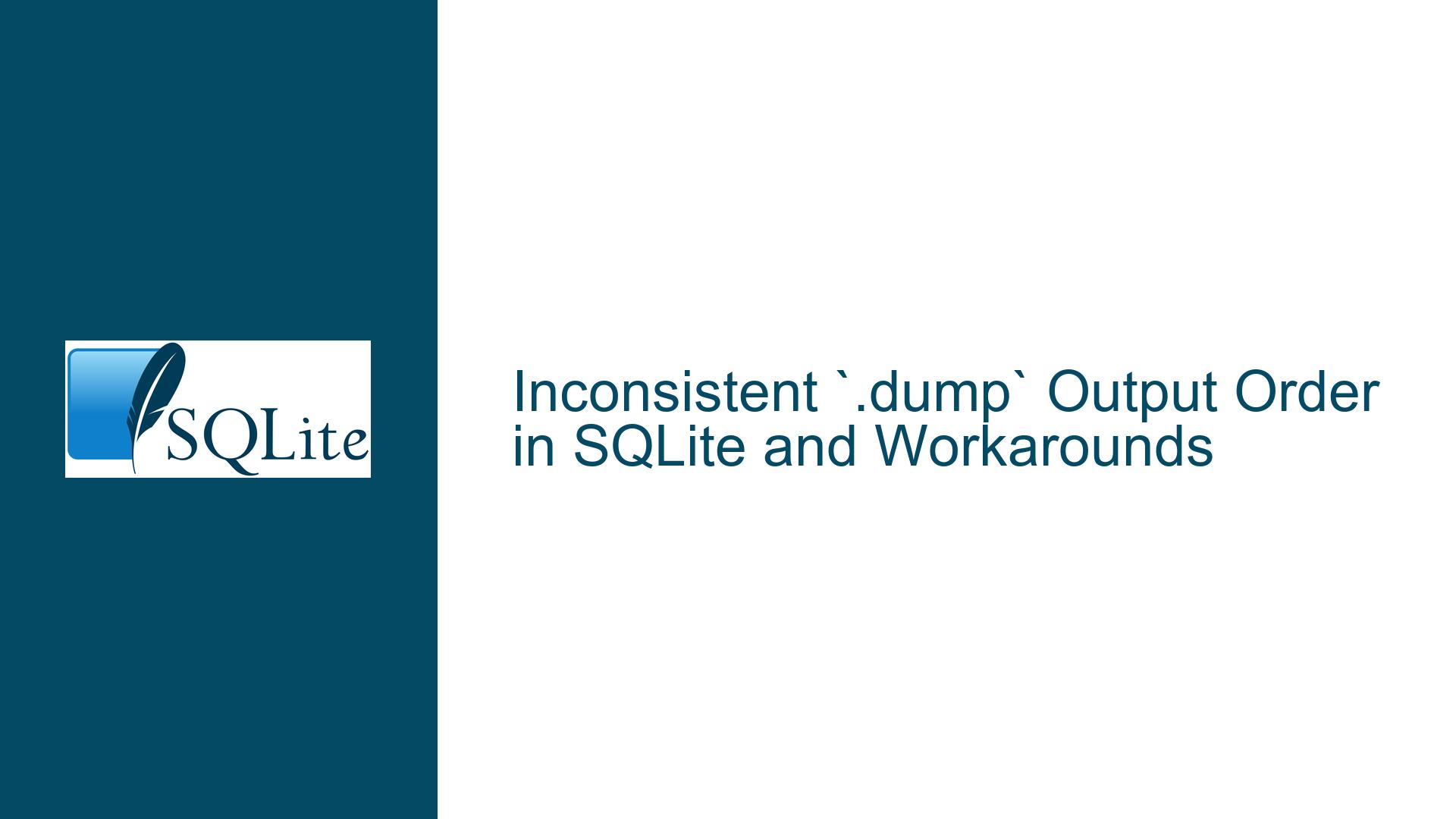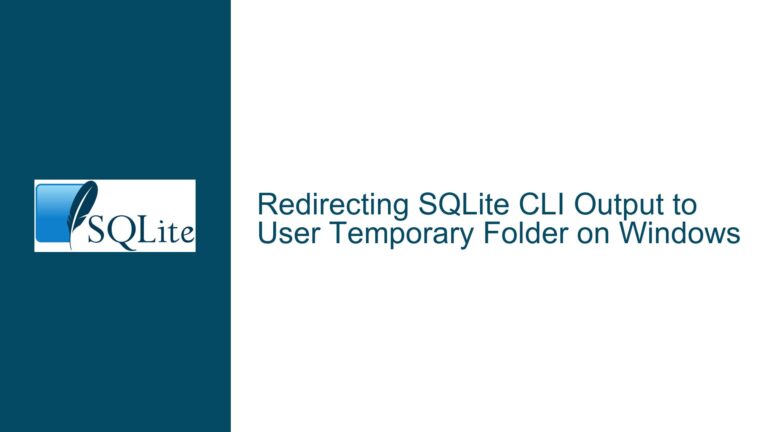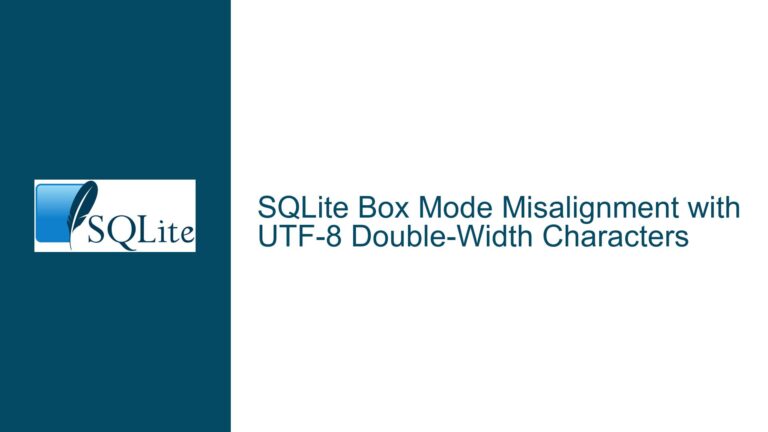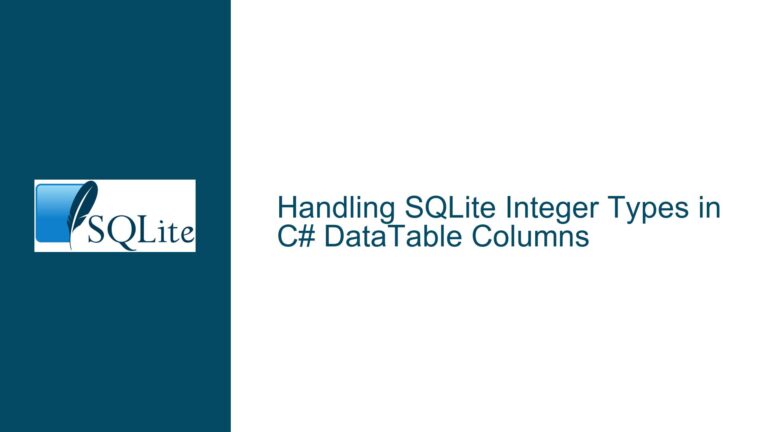Inconsistent `.dump` Output Order in SQLite and Workarounds
SQLite .dump Command Produces Inconsistent Table Ordering
The SQLite .dump command is a powerful utility for exporting the entire schema and data of a database into a text file. However, a significant issue arises when the order of tables, indexes, and triggers in the output of the .dump command is inconsistent. This inconsistency occurs because the .dump command retrieves objects from the sqlite_master table in the order of their rowid or insertion order, rather than a deterministic or logical order. This behavior can lead to unnecessary complications when comparing database dumps, especially when using version control systems like Git. The problem is exacerbated when tables or views are modified, as the resulting diff can be confusing and difficult to interpret due to the reordering of objects in the .dump output.
The issue is not limited to tables alone. Indexes, triggers, and other database objects are also affected, as they are not explicitly ordered within a single call to .dump. This lack of consistent ordering can cause problems when attempting to restore a database from a dump file, particularly when dependencies between objects (such as foreign key relationships) are involved. The problem is further compounded when considering additional database settings like PRAGMA application_id, PRAGMA user_version, and PRAGMA page_size, which are not included in the .dump output by default. These settings are crucial for fully restoring a database to its original state.
Root Causes of Inconsistent .dump Ordering
The root cause of the inconsistent .dump output lies in the SQLite implementation of the .dump command. Specifically, the command retrieves objects from the sqlite_master table using a query that orders the results based on the rowid of the entries. The rowid is an internal identifier that reflects the order in which objects were inserted into the database. This approach does not account for logical dependencies between objects or provide a deterministic ordering that would be useful for version control or database restoration.
The query used by the .dump command is as follows:
SELECT name, type, sql FROM sqlite_master
WHERE (%s) AND type=='table'
AND sql NOT NULL
ORDER BY tbl_name='sqlite_sequence', rowid;
The ORDER BY clause in this query prioritizes the sqlite_sequence table (used for auto-incrementing columns) and then falls back to the rowid for all other tables. This approach does not guarantee a consistent or logical order for the remaining objects, leading to the observed inconsistencies in the .dump output.
Additionally, the .dump command does not account for the hierarchical relationships between database objects. For example, indexes and triggers depend on tables, and child tables with foreign key constraints depend on their parent tables. Without considering these dependencies, the .dump output may include objects in an order that violates these relationships, potentially causing errors during database restoration.
Implementing Deterministic .dump Ordering and Dependency Handling
To address the issue of inconsistent .dump output, several approaches can be taken. These range from modifying the .dump command’s source code to implementing user-space workarounds. Each approach has its own advantages and limitations, and the choice of method depends on the specific requirements and constraints of the use case.
Modifying the .dump Command Source Code
One solution is to modify the source code of the .dump command to enforce a deterministic ordering of database objects. This can be achieved by altering the ORDER BY clause in the query used to retrieve objects from the sqlite_master table. For example, the query could be modified to order objects by type, table name, and object name, ensuring a consistent output order. The modified query might look like this:
SELECT name, type, sql FROM sqlite_master
WHERE (%s) AND sql NOT NULL
ORDER BY
CASE
WHEN type='table' THEN 1
WHEN type='index' THEN 2
WHEN type='trigger' THEN 3
ELSE 4
END,
tbl_name, name;
This query orders tables first, followed by indexes, triggers, and other objects. Within each type, objects are ordered by their table name and object name, ensuring a consistent and logical output order.
However, this approach requires rebuilding SQLite from source, which may not be feasible for all users. Additionally, it does not address the issue of dependency ordering, which is critical for restoring databases with foreign key constraints or other inter-object dependencies.
User-Space Workarounds for Consistent .dump Output
For users who cannot modify the SQLite source code, several user-space workarounds can be implemented to achieve consistent .dump output. One such workaround involves scripting the .dump command to explicitly order tables, indexes, and triggers. This can be done using a shell script or a similar automation tool. For example:
for tbl in $(sqlite3 $db "SELECT name FROM sqlite_master WHERE type=='table' ORDER BY name"); do
sqlite3 $db ".dump $tbl"
done > yourdumpfile
This script retrieves the names of all tables in the database, orders them by name, and then calls the .dump command for each table individually. While this approach ensures a consistent order for tables, it does not address the ordering of indexes, triggers, or other objects.
To handle all object types, a more comprehensive script is required. The following script retrieves all objects from the sqlite_master table, orders them by type and name, and then calls the .dump command for each object:
sqlite3 $db "SELECT type, name, tbl_name FROM sqlite_master
WHERE sql NOT NULL
ORDER BY
CASE
WHEN type='table' THEN 1
WHEN type='index' THEN 2
WHEN type='trigger' THEN 3
ELSE 4
END,
tbl_name, name" | while read -r type name tbl_name; do
sqlite3 $db ".dump $name"
done > yourdumpfile
This script ensures that tables are dumped first, followed by indexes, triggers, and other objects. Within each type, objects are ordered by their table name and object name, providing a consistent and logical output order.
Handling Dependencies and Foreign Key Constraints
When dealing with databases that include foreign key constraints or other dependencies, additional steps are required to ensure that objects are dumped in an order that respects these relationships. For example, parent tables must be dumped before their child tables to avoid foreign key violations during restoration. This can be achieved by modifying the script to account for dependency ordering.
The following script retrieves all objects from the sqlite_master table, orders them by type and name, and then dumps them in an order that respects foreign key constraints:
sqlite3 $db "PRAGMA foreign_key_list($tbl_name)" | while read -r id seq table from to on_update on_delete match; do
# Recursively dump parent tables
sqlite3 $db ".dump $table"
done
sqlite3 $db "SELECT type, name, tbl_name FROM sqlite_master
WHERE sql NOT NULL
ORDER BY
CASE
WHEN type='table' THEN 1
WHEN type='index' THEN 2
WHEN type='trigger' THEN 3
ELSE 4
END,
tbl_name, name" | while read -r type name tbl_name; do
sqlite3 $db ".dump $name"
done > yourdumpfile
This script first dumps all parent tables referenced by foreign key constraints, ensuring that they are available when their child tables are restored. It then dumps the remaining objects in a consistent order, as described earlier.
Including Additional PRAGMA Settings in .dump Output
To fully restore a database from a dump file, it is often necessary to include additional PRAGMA settings such as application_id, user_version, and page_size. These settings are not included in the .dump output by default, but they can be added manually or through scripting.
The following script retrieves the current values of these PRAGMA settings and includes them in the dump file:
{
sqlite3 $db "PRAGMA application_id;"
sqlite3 $db "PRAGMA user_version;"
sqlite3 $db "PRAGMA page_size;"
sqlite3 $db "SELECT type, name, tbl_name FROM sqlite_master
WHERE sql NOT NULL
ORDER BY
CASE
WHEN type='table' THEN 1
WHEN type='index' THEN 2
WHEN type='trigger' THEN 3
ELSE 4
END,
tbl_name, name" | while read -r type name tbl_name; do
sqlite3 $db ".dump $name"
done
} > yourdumpfile
This script ensures that the dump file includes all necessary PRAGMA settings, allowing the database to be fully restored to its original state.
Avoiding Database Corruption During Workarounds
One potential pitfall of user-space workarounds is the risk of database corruption. For example, attempting to manually reorder the sqlite_master table by copying its contents to a temporary table and then reinserting them can lead to orphaned indexes or other inconsistencies. This approach should be avoided unless absolutely necessary, as it can result in a corrupted database that is difficult to repair.
Instead, it is recommended to use scripting or other external tools to achieve consistent .dump output without modifying the database schema directly. This approach minimizes the risk of corruption and ensures that the database remains in a valid state throughout the process.
Conclusion
The inconsistent ordering of objects in the SQLite .dump output can cause significant challenges when comparing or restoring databases. By understanding the root causes of this issue and implementing appropriate workarounds, users can achieve consistent and deterministic .dump output that meets their needs. Whether through modifying the SQLite source code, scripting the .dump command, or handling dependencies and PRAGMA settings, there are multiple approaches to addressing this issue. Care must be taken to avoid database corruption and ensure that all necessary settings and dependencies are included in the dump file. With these considerations in mind, users can effectively manage their SQLite databases and avoid the pitfalls of inconsistent .dump output.





